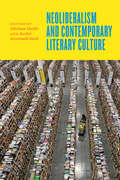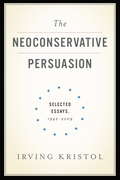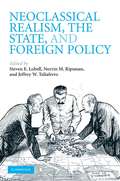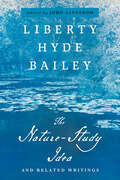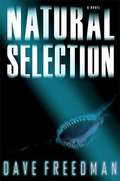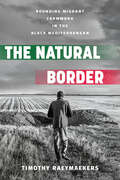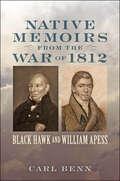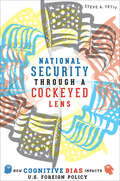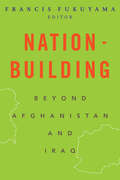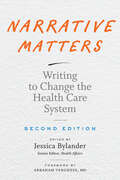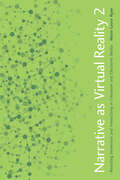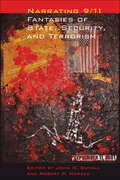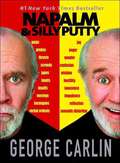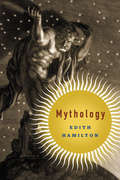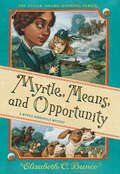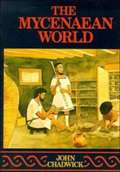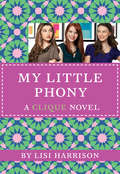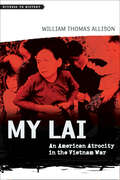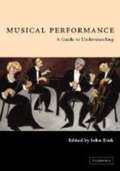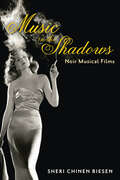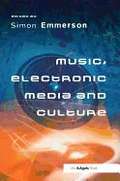- Table View
- List View
Neoliberalism and Contemporary Literary Culture
by Mitchum Huehls Rachel Greenwald SmithNeoliberalism has been a buzzword in literary studies for well over a decade, but its meaning remains ambiguous and its salience contentious. In Neoliberalism and Contemporary Literary Culture, Mitchum Huehls and Rachel Greenwald Smith offer a wide-ranging exploration of contemporary literature through the lens of neoliberalism;€™s economic, social, and cultural ascendance. Bringing together accessible and provocative essays from top literary scholars, this innovative collection examines neoliberalism;€™s influence on literary theory and methodology, literary form, literary representation, and literary institutions. A four-phase approach to the historical emergence of neoliberalism from the early 1970s to the present helps to clarify the complexity of the relationship between neoliberalism and literary culture. Layering that history over the diverse changes in a US-Anglo literary field that has moved away from postmodern forms and sensibilities, the book argues that many literary developments;¢;‚¬;€?including the return to realism, the rise of the memoir, the embrace of New Materialist theory, and the pursuit of aesthetic autonomy;¢;‚¬;€?make more coherent sense when viewed in light of neoliberalism;€™s ever-increasing expansion into the cultural sphere.The essays gathered here engage a diverse range of theorists, including Michel Foucault, Wendy Brown, Giorgio Agamben, Bruno Latour, Maurice Merleau-Ponty, Gary Becker, and Eve Sedgwick to address the reciprocal relationship between neoliberalism and conceptual fields such as biopolitics, affect, phenomenology, ecology, and new materialist ontology. These theoretical perspectives are complemented by innovative readings of contemporary works of literature by writers such as Jennifer Egan, Ben Lerner, Gillian Flynn, Teju Cole, Jonathan Franzen, Chimamanda Ngozi Adichie, Salvador Plascencia, E. L. James, Lisa Robertson, Kenneth Goldsmith, and many others. Neoliberalism and Contemporary Literary Culture is essential reading for anyone invested in the ever-changing state of literary culture.
Neoliberalism and Contemporary Literary Culture
by Mitchum Huehls Rachel Greenwald SmithNeoliberalism has been a buzzword in literary studies for well over a decade, but its meaning remains ambiguous and its salience contentious. In Neoliberalism and Contemporary Literary Culture, Mitchum Huehls and Rachel Greenwald Smith offer a wide-ranging exploration of contemporary literature through the lens of neoliberalism;€™s economic, social, and cultural ascendance. Bringing together accessible and provocative essays from top literary scholars, this innovative collection examines neoliberalism;€™s influence on literary theory and methodology, literary form, literary representation, and literary institutions. A four-phase approach to the historical emergence of neoliberalism from the early 1970s to the present helps to clarify the complexity of the relationship between neoliberalism and literary culture. Layering that history over the diverse changes in a US-Anglo literary field that has moved away from postmodern forms and sensibilities, the book argues that many literary developments;¢;‚¬;€?including the return to realism, the rise of the memoir, the embrace of New Materialist theory, and the pursuit of aesthetic autonomy;¢;‚¬;€?make more coherent sense when viewed in light of neoliberalism;€™s ever-increasing expansion into the cultural sphere.The essays gathered here engage a diverse range of theorists, including Michel Foucault, Wendy Brown, Giorgio Agamben, Bruno Latour, Maurice Merleau-Ponty, Gary Becker, and Eve Sedgwick to address the reciprocal relationship between neoliberalism and conceptual fields such as biopolitics, affect, phenomenology, ecology, and new materialist ontology. These theoretical perspectives are complemented by innovative readings of contemporary works of literature by writers such as Jennifer Egan, Ben Lerner, Gillian Flynn, Teju Cole, Jonathan Franzen, Chimamanda Ngozi Adichie, Salvador Plascencia, E. L. James, Lisa Robertson, Kenneth Goldsmith, and many others. Neoliberalism and Contemporary Literary Culture is essential reading for anyone invested in the ever-changing state of literary culture.
The Neoconservative Persuasion: Selected Essays, 1942-2009
by Irving KristolIrving Kristol, the "godfather" of neoconservatism and one of our most important public intellectuals, played an extraordinarily influential role in the development of American intellectual and political culture over the past half century. These essays, many hard to find and reprinted here for the first time since their initial appearance, are a penetrating survey of the intellectual development of one of the progenitors of neoconservatism.Kristol wrote over the years on a remarkably broad range of topics--from W. H. Auden to Ronald Reagan, from the neoconservative movement's roots in the 1940s at City College to American foreign policy, from religion to capitalism. Kristol's writings provide us with a unique guide to the development of neoconservatism as one of the leading strains of thought--one of the leading "persuasions"--in recent American political and intellectual history.
Neoclassical Realism, the State, and Foreign Policy (PDF)
by Jeffrey W Taliaferro Steven E Lobell Norrin M RipsmanNeoclassical realism is an important new approach to international relations. Focusing on the interaction of the international system and the internal dynamics of states, neoclassical realism seeks to explain the grand strategies of individual states as opposed to recurrent patterns of international outcomes. This book offers the first systematic survey of the neoclassical realist approach.
The Nature-Study Idea: And Related Writings (The Liberty Hyde Bailey Library)
by Liberty Hyde BaileyIn The Nature-Study Idea, Liberty Hyde Bailey articulated the essence of a social movement, led by ordinary public-school teachers, that lifted education out of the classroom and placed it into firsthand contact with the natural world. The aim was simple but revolutionary: sympathy with nature to increase the joy of living and foster stewardship of the earth.With this definitive edition, John Linstrom reintroduces The Nature-Study Idea as an environmental classic for our time. It provides historical context through a wealth of related writings, and introductory essays relate Bailey's vision to current work in education and the intersection of climate change and culture. In this period of planetary turmoil, Bailey's ambition to cultivate wonder (in adults as well as children) and lead readers back into the natural world is more important than ever.
Natural Selection: A Novel
by Dave FreedmanA shocking biological discovery. A previously unknown predatory species. Evolving just like the dinosaurs. Now. Today. Being forced out of its world and into man's for a violent first encounter.Weaving science and thriller in a way not seen since Jurassic Park, Natural Selection introduces a phenomenally dangerous new species that is rapidly adapting in a way never before seen.A mystery. A chase. A vast expansive puzzle. A team of marine scientists is on the verge of making the most stunning discovery in the history of man. In their quest for answers, they engage a host of fascinating characters. The world's premier neurology expert. A specialist on animal teeth. Flight simulation wizards, evolution historians, deep sea geologists, and so many more.Along the way, the team of six men and women experience love, friendship, loyalty and betrayal. Together, they set off to exotic locales. Literally to the bottom of the ocean. To a vast and mysterious redwood forest. To an unknown complex of massive caves. When people start dying, the stakes are upped even further. Then the real hunt begins. . . .Loaded with astonishing action sequences, Natural Selection is that rare breed of thriller, filled with intricately layered research, real three-dimensional characters, and tornado pacing.
Natural Selection: A Novel
by Dave FreedmanA shocking biological discovery. A previously unknown predatory species. Evolving just like the dinosaurs. Now. Today. Being forced out of its world and into man's for a violent first encounter. Weaving science and thriller in a way not seen since Jurassic Park, Natural Selection introduces a phenomenally dangerous new species that is rapidly adapting in a way never before seen. A mystery. A chase. A vast expansive puzzle. A team of marine scientists is on the verge of making the most stunning discovery in the history of man. In their quest for answers, they engage a host of fascinating characters. The world's premier neurology expert. A specialist on animal teeth. Flight simulation wizards, evolution historians, deep sea geologists, and so many more. Along the way, the team of six men and women experience love, friendship, loyalty and betrayal. Together, they set off to exotic locales. Literally to the bottom of the ocean. To a vast and mysterious redwood forest. To an unknown complex of massive caves. When people start dying, the stakes are upped even further. Then the real hunt begins. . . . Loaded with astonishing action sequences, Natural Selection is that rare breed of thriller, filled with intricately layered research, real three-dimensional characters, and tornado pacing.
The Natural Border: Bounding Migrant Farmwork in the Black Mediterranean
by Timothy RaeymaekersThe Natural Border tells the recent history of Mediterranean rural capitalism from the perspective of marginalized Black African farm workers. Timothy Raeymaekers shows how in the context of global supply chains and repressive border regimes, agrarian production and reproduction are based on fundamental racial hierarchies.Taking the example of the tomato—a typical 'Made in Italy' commodity—Raeymaekers asks how political boundaries are drawn around the land and the labor needed for its production, what technologies of exclusion and inclusion enable capitalist operations to take place in the Mediterranean agrarian frontier, and which practices structure the allocation, use and commodification of land and labor across the tomato chain. While the mobile infrastructures that mobilize, channel, commodify and segregate labor play a central role in the 'naturalization' of racial segregation, they are also terrains of contestation and power—and thus, as The Natural Border demonstrates, reflect the tense socio-ecological transformation the Mediterranean border space is going through today.
Native Memoirs from the War of 1812: Black Hawk and William Apess (Johns Hopkins Books on the War of 1812)
by Carl BennNative peoples played major roles in the War of 1812 as allies of both the United States and Great Britain, but few wrote about their conflict experiences. Two famously wrote down their stories: Black Hawk, the British-allied chief of the still-independent Sauks from the upper Mississippi, and American soldier William Apess, a Christian convert from the Pequots who lived on a reservation in Connecticut. Carl Benn explores the wartime passages of their autobiographies, in which they detail their decisions to take up arms, their experiences in the fighting, their broader lives within the context of native-newcomer relations, and their views on such critical issues as aboriginal independence. Scholars, students, and general readers interested in indigenous and military history in the early American republic will appreciate these important memoirs, along with Benn's helpful introductions and annotations.
National Security through a Cockeyed Lens: How Cognitive Bias Impacts U.S. Foreign Policy
by Steve A. Yetiv"How do mental errors or cognitive biases undermine good decision making?" This is the question Steve A. Yetiv takes up in his latest foreign policy study, National Security through a Cockeyed Lens.Yetiv draws on four decades of psychological, historical, and political science research on cognitive biases to illuminate some of the key pitfalls in our leaders’ decision-making processes and some of the mental errors we make in perceiving ourselves and the world.Tracing five U.S. national security episodes—the 1979 Soviet invasion and occupation of Afghanistan; the Iran-Contra affair during the Reagan administration; the rise of al-Qaeda, leading to the 9/11 attacks; the 2003 U.S. invasion of Iraq; and the development of U.S. energy policy—Yetiv reveals how a dozen cognitive biases have been more influential in impacting U.S. national security than commonly believed or understood. Identifying a primary bias in each episode—disconnect of perception versus reality, tunnel vision ("focus feature"), distorted perception ("cockeyed lens"), overconfidence, and short-term thinking—Yetiv explains how each bias drove the decision-making process and what the outcomes were for the various actors. His concluding chapter examines a range of debiasing techniques, exploring how they can improve decision making.
National Security through a Cockeyed Lens: How Cognitive Bias Impacts U.S. Foreign Policy
by Steve A. Yetiv"How do mental errors or cognitive biases undermine good decision making?" This is the question Steve A. Yetiv takes up in his latest foreign policy study, National Security through a Cockeyed Lens.Yetiv draws on four decades of psychological, historical, and political science research on cognitive biases to illuminate some of the key pitfalls in our leaders’ decision-making processes and some of the mental errors we make in perceiving ourselves and the world.Tracing five U.S. national security episodes—the 1979 Soviet invasion and occupation of Afghanistan; the Iran-Contra affair during the Reagan administration; the rise of al-Qaeda, leading to the 9/11 attacks; the 2003 U.S. invasion of Iraq; and the development of U.S. energy policy—Yetiv reveals how a dozen cognitive biases have been more influential in impacting U.S. national security than commonly believed or understood. Identifying a primary bias in each episode—disconnect of perception versus reality, tunnel vision ("focus feature"), distorted perception ("cockeyed lens"), overconfidence, and short-term thinking—Yetiv explains how each bias drove the decision-making process and what the outcomes were for the various actors. His concluding chapter examines a range of debiasing techniques, exploring how they can improve decision making.
Nation-Building: Beyond Afghanistan and Iraq (Forum on Constructive Capitalism)
by Francis FukuyamaBestselling author Francis Fukuyama brings together esteemed academics, political analysts, and practitioners to reflect on the U.S. experience with nation-building, from its historical underpinnings to its modern-day consequences. The United States has sought on repeated occasions to reconstruct states damaged by conflict, from Reconstruction in the South after the Civil War to Japan and Germany after World War II, to the ongoing rebuilding of Iraq. Despite this rich experience, there has been remarkably little systematic effort to learn lessons on how outside powers can assist in the building of strong and self-sufficient states in post-conflict situations.The contributors dissect mistakes, false starts, and lessons learned from the cases of Afghanistan and Iraq within the broader context of reconstruction efforts in other parts of the world, including Latin America, Japan, and the Balkans. Examining the contrasting models in Afghanistan and Iraq, they highlight the Coalition Provisional Authority in Iraq as a cautionary example of inadequate planning. The need for post-conflict reconstruction will not cease with the end of the Afghanistan and Iraq missions. This timely volume offers the critical reflection and evaluation necessary to avoid repeating costly mistakes in the future.Contributors: Larry Diamond, Hoover Institution and Stanford University; James Dobbins, RAND; David Ekbladh, American University; Michèle A. Flournoy, Center for Strategic and International Studies; Francis Fukuyama, Paul H. Nitze School of Advanced International Studies, Johns Hopkins University; Larry P. Goodson, U.S. Army War College; Johanna Mendelson Forman, UN Foundation; Minxin Pei, Samia Amin, and Seth Garz, Carnegie Endowment for International Peace; S. Frederick Starr, Central Asia–Caucacus Institute at Johns Hopkins School of Advanced International Studies; F. X. Sutton, Ford Foundation Emeritus; Marvin G. Weinbaum, University of Illinois at Urbana–Champaign
Narrative Matters: Writing to Change the Health Care System
by Jessica BylanderHealth care decision making affects patients and families first and foremost, yet their perspectives are not always factored into health policy deliberations and discussions. In this anthology, Jessica Bylander brings together the personal stories of the patients, physicians, caregivers, policy makers, and others whose writings add much-needed human context to health care decision making.Drawn from the popular "Narrative Matters" column in the leading health policy journal Health Affairs, this collection features essays by some of the leading minds in health care today, including Pulitzer Prize–winner Siddhartha Mukherjee, MacArthur fellow Diane Meier, former Planned Parenthood president Leana S. Wen, and former secretary of health and human services Louis W. Sullivan. The collection also presents important stories from lesser-known voices, including a transgender doctor in Oklahoma who calls for better treatment of trans patients and a palliative care physician who reflects on how perspectives on hastening death have changed in recent years. A foreword written by National Humanities Medal recipient Abraham Verghese, MD, further rounds out the book.The collection of thirty-two essays is organized around several themes:• the practice of medicine • medical innovation and research• patient-centered care• the doctor-patient relationship• disparities and discrimination• aging and end-of-life care• maternity and childbirth• opioids and substance abuseThe narratives in this timely and diverse collection remind readers of the real people affected by health policy decisions and offer clear calls for policy action to improve health care. Narrative Matters is a powerful argument for humane, patient-centered care.Contributors: Louise Aronson, Laura Arrowsmith, Cheryl Bettigole, Cindy Brach, Gary Epstein-Lubow, Jonathan Friedlaender, Patricia Gabow, Katti Gray, Yasmin Sokkar Harker, Timothy Hoff, Carla Keirns, Raya Elfadel Kheirbek, Katy B. Kozhimannil, Pooja Lagisetty, Maria Maldonado, Maureen A. Mavrinac, Diane E. Meier, Dina Keller Moss, Siddhartha Mukherjee, Donna Jackson Nakazawa, Travis N. Rieder, Aroonsiri Sangarlangkarn, Elaine Schattner, Janice Lynch Schuster, Myrick C. Shinall, Gayathri Subramanian, Louis W. Sullivan, Gautham K. Suresh, Abraham Verghese, Otis Warren, Leana S. Wen, Charlotte Yeh
Narrative as Virtual Reality 2: Revisiting Immersion and Interactivity in Literature and Electronic Media (Parallax: Re-visions of Culture and Society)
by Marie-Laure RyanIs there a significant difference between engagement with a game and engagement with a movie or novel? Can interactivity contribute to immersion, or is there a trade-off between the immersive "world" aspect of texts and their interactive "game" dimension? As Marie-Laure Ryan demonstrates in Narrative as Virtual Reality 2, the questions raised by the new interactive technologies have their precursors and echoes in pre-electronic literary and artistic traditions. Approaching the idea of virtual reality as a metaphor for total art, Ryan applies the concepts of immersion and interactivity to develop a phenomenology of narrative experience that encompasses reading, watching, and playing. The book weighs traditional literary narratives against the new textual genres made possible by the electronic revolution of the past thirty years, including hypertext, electronic poetry, interactive drama, digital installation art, computer games, and multi-user online worlds like Second Life and World of Warcraft.In this completely revised edition, Ryan reflects on the developments that have taken place over the past fifteen years in terms of both theory and practice and focuses on the increase of narrativity in video games and its corresponding loss in experimental digital literature. Following the cognitive approaches that have rehabilitated immersion as the product of fundamental processes of world-construction and mental simulation, she details the many forms that interactivity has taken�or hopes to take�in digital texts, from determining the presentation of signs to affecting the level of story.
Narrating 9/11: Fantasies of State, Security, and Terrorism (A <I>Modern Fiction Studies</I> Book)
by John N. Duvall Robert P. MarzecNarrating 9/11 challenges the notion that Americans have overcome the national trauma of the terrorist attacks on the World Trade Center and the Pentagon. The volume responds to issues of war, surveillance, and the expanding security state, including the Bush Administration’s policies on preemptive war, extraordinary rendition, torture abroad, and the suspension of privacy rights and civil liberties at home.Building on the work of Giorgio Agamben, Slavoj Žižek, and Donald Pease, the contributors focus on the ways in which post-9/11 narratives help make visible the fantasies that attempt to justify the ongoing state of exception and American exceptionalism. Narrating 9/11 examines a variety of contemporary narratives as they relate to the cultural construction of the neoliberal nation-state, a role that mediates the possibilities of ethnic and religious identity as well as the ability to imagine terrorism. Touching on some of the mainstays of 9/11 fiction, including Jonathan Safran Foer’s Extremely Loud & Incredibly Close and John Updike’s Terrorist, the book expands this particular canon by considering the work of such writers as Jess Walter, William Gibson, Lauren Groff, Ken Kalfus, Ian McEwan, Philip Roth, John le Carré, Laila Halaby, Michael Chabon, and Jarett Kobek. Narrating 9/11 pushes beyond a critical focus on domestic realism, offering chapters that examine speculative and genre fiction, postmodernism, climate change, and the evolving security state, as well as the television series Lost and the film Paradise Now.
Napalm & Silly Putty
by George CarlinA hilarious new collection of razor-sharp observations from the New York Times bestselling author of Brain Droppings. Few comics make the transition from stage to page as smoothly or successfully as George Carlin. Brain Droppings spent a total of 40 weeks on the New York Times bestseller list, and this new one is certain to tickle even more ribs (and rattle a few more cages) with its characteristically ironic take on life's annoying universal truths. In Napalm & Silly Putty, Carlin doesn't steer clear of the tough issues, preferring instead to look life boldly in the eye to pose the questions few dare to ask:How can it be a spy satellite if they announce on TV that it's a spy satellite?Why do they bother saying "raw sewage"? Do some people cook that stuff?In the expression "topsy-turvy," what exactly is meant by "turvy"? And he makes some startling observations, including:Most people with low self-esteem have earned it.Guys don't seem to be called "Lefty" anymore.Most people don't know what they're doing, and a lot of them are really good at it. Carlin also waxes wickedly philosophical on all sorts of subjects, including:KIDS--They're not all cute. In fact, if you look at them closely, some of them are rather unpleasant looking. And a lot of them don't smell too good either.DEATH ROW--If you're condemned to die they have to give you one last meal of your own request. What is that all about? A group of people plan to kill you, so they want you to eat something you like? Add to the mix "The Ten Most Embarrassing Songs of All Time," "The 20th Century Hostility Scoreboard," and "People I Can Do Without," and you have an irresistibly insouciant assortment of musings, questions, assertions, and assumptions guaranteed to please the millions of fans waiting for the next Carlin collection--and the millions more waiting to discover this comic genius.
Mythology: Timeless Tales Of Gods And Heroes (Mentor Ser.)
by Edith Hamilton Aphrodite Trust Apollo TrustThe world-renowned classic that has enthralled and delighted millions of readers with its timeless tales of gods and heroes.Edith Hamilton's mythology succeeds like no other book in bringing to life for the modern reader the Greek, Roman and Norse myths that are the keystone of Western culture-the stories of gods and heroes that have inspired human creativity from antiquity to the present.We follow the drama of the Trojan War and the wanderings of Odysseus. We hear the tales of Jason and the Golden Fleece, Cupid and Psyche, and mighty King Midas. We discover the origins of the names of the constellations. And we recognize reference points for countless works for art, literature and culture inquiry-from Freud's Oedipus complex to Wagner's Ring Cycle of operas to Eugene O'Neill's Mourning Becomes ElectraBoth a reference text for scholars of all ages and a book to simply enjoy, Mythology is a classic not to be missed.
Myrtle, Means, and Opportunity (Myrtle Hardcastle Mystery 5)
by Elizabeth C. BunceIn the fifth book of the Edgar Award-winning series, Myrtle Hardcastle uncovers a string of murders during a treasure hunt on a haunted Scottish estate. When her governess inherits an estate on a Scottish island, amateur detective Myrtle Hardcastle couldn't be more excited. Unfortunately, the ancestral castle is both run-down and haunted. Ghostly moans echo in the walls, and there are rumors of a cursed treasure lost on the island—an ancient silver brooch that may have cost the former lord his life. But who had the motive, means, and opportunity to kill him? And could this Scottish trip mean the end of Myrtle's plans to get her father and governess together? Then Myrtle's investigation stirs a villain out of hiding. The estate&’s boat is stolen, so there&’s no escape from the island. Myrtle is forced to play a deadly game, hunting for the brooch with a thief breathing down her neck—someone who will stop at nothing to get the treasure, even if it means murder.
The Mycenaean World (PDF)
by John ChadwickJohn Chadwick summarizes the results of research into Mycenaean Greece and in so doing opens the door to a new world, Mycenaean Greece seen through the eyes of its inhabitants.
My Little Phony (The Clique #13)
by Lisi HarrisonSugar, spice, and everything lice.Massie Block: The holidays are just around the corner, and the only thing Massie doesn't want for Christmas is a lip-kiss from her ninth-grade crush, Landon. Not that she'd ever admit it, but she's nervous! To distract herself, Massie focuses on getting revenge on Claire for ditching the Pretty Committee. But when the plan to bug her ex-BFF backfires big-time, she may find herself headed for a Merry Kissmass-whether she likes it or not.Alicia Rivera: Promised her parents she wouldn't shop at awl between Thanksgiving and Christmas. Her reward? An all-expenses-paid trip to the Spanish Riviera. But what happens when she sees the cuh-yutest pair of Ralph Lauren sunglasses? No pain, no Spain.Dylan Marvil: After going overboard at the Westchester Mall, Dylan isn't worried about the size of her clothes . . . but she is worried about the size of her clothing budget. Cuh-redit denied!Kristen Gregory: Is sick of being the only poor girl in Westchester. But misery loves company, and maybe, just maybe, she won't be the only broke member of the Pretty Committee for long. . . .Claire Lyons: When Massie scares off her new drama friends with a fake-lice scare, Claire decides she's done letting Massie bully her. The alpha may have exterminated Claire's social life, but what goes around comes around. The raid is on, and it won't be over until the fat ladybug sings.The Clique . . . the only thing harder than getting in is staying in.
My Lai: An American Atrocity in the Vietnam War (Witness to History)
by William Thomas AllisonOn March 16, 1968, American soldiers killed as many as five hundred Vietnamese men, women, and children in a village near the South China Sea. In My Lai William Thomas Allison explores and evaluates the significance of this horrific event. How could such a thing have happened? Who (or what) should be held accountable? How do we remember this atrocity and try to apply its lessons, if any? My Lai has fixed the attention of Americans of various political stripes for more than forty years. The breadth of writing on the massacre, from news reports to scholarly accounts, highlights the difficulty of establishing fact and motive in an incident during which confusion, prejudice, and self-preservation overwhelmed the troops. Son of a Marine veteran of the Vietnam War—and aware that the generation who lived through the incident is aging—Allison seeks to ensure that our collective memory of this shameful episode does not fade.Well written and accessible, Allison’s book provides a clear narrative of this historic moment and offers suggestions for how to come to terms with its aftermath.
Musical Performance: A Guide to Understanding (PDF)
by John RinkFrom performance history to the essentials of practice and memorisation, from performance anxiety to the art of listening and criticism, this accessible guide for students, teachers and performers at all levels unravels the complexities of musical performance, focusing on key aspects of learning, playing and responding to music.
Music in the Shadows: Noir Musical Films
by Sheri Chinen BiesenSmoke. Shadows. Moody strains of jazz. Welcome to the world of "noir musical" films, where tormented antiheroes and hard-boiled musicians battle obsession and struggle with their music and ill-fated love triangles. Sultry divas dance and sing the blues in shrouded nightclubs. Romantic intrigue clashes with backstage careers. In her pioneering study, Music in the Shadows, film noir expert Sheri Chinen Biesen explores musical films that use film noir style and bluesy strains of jazz to inhabit a disturbing underworld and reveal the dark side of fame and the American Dream. While noir musical films like A Star Is Born include musical performances, their bleak tone and expressionistic aesthetic more closely resemble the visual style of film noir. Their narratives unfold behind a stark noir lens: distorted, erratic angles and imbalanced hand-held shots allow the audience to experience a tortured, disillusioned perspective.While many musicals glamorize the quest for the spotlight in Hollywood's star factory, brooding noir musical films such as Blues in the Night, Gilda, The Red Shoes, West Side Story, and Round Midnight stretch the boundaries of film noir and the musical as film genres collide. Deep shadows, dim lighting, and visual composition evoke moodiness, cynicism, pessimism, and subjective psychological points of view.As in her earlier study of film noir, Blackout: World War II and the Origins of Film Noir, Biesen draws on extensive primary research in studio archives to situate her examination within a historical, industrial, and cultural context.
Music in the Shadows: Noir Musical Films
by Sheri Chinen BiesenSmoke. Shadows. Moody strains of jazz. Welcome to the world of "noir musical" films, where tormented antiheroes and hard-boiled musicians battle obsession and struggle with their music and ill-fated love triangles. Sultry divas dance and sing the blues in shrouded nightclubs. Romantic intrigue clashes with backstage careers. In her pioneering study, Music in the Shadows, film noir expert Sheri Chinen Biesen explores musical films that use film noir style and bluesy strains of jazz to inhabit a disturbing underworld and reveal the dark side of fame and the American Dream. While noir musical films like A Star Is Born include musical performances, their bleak tone and expressionistic aesthetic more closely resemble the visual style of film noir. Their narratives unfold behind a stark noir lens: distorted, erratic angles and imbalanced hand-held shots allow the audience to experience a tortured, disillusioned perspective.While many musicals glamorize the quest for the spotlight in Hollywood's star factory, brooding noir musical films such as Blues in the Night, Gilda, The Red Shoes, West Side Story, and Round Midnight stretch the boundaries of film noir and the musical as film genres collide. Deep shadows, dim lighting, and visual composition evoke moodiness, cynicism, pessimism, and subjective psychological points of view.As in her earlier study of film noir, Blackout: World War II and the Origins of Film Noir, Biesen draws on extensive primary research in studio archives to situate her examination within a historical, industrial, and cultural context.
Music, Electronic Media And Culture (PDF)
by Simon EmmersonTechnology revolutionised the ways that music was produced in the twentieth century. As that century drew to a close and a new century begins a new revolution in roles is underway. The separate categories of composer, performer, distributor and listener are being challenged, while the sounds of the world itself become available for musical use. All kinds of sounds are now brought into the remit of composition, enabling the music of others to be sampled (or plundered), including that of unwitting musicians from non-western cultures. This sound world may appear contradictory - stimulating and invigorating as well as exploitative and destructive. This book addresses some of the issues now posed by the brave new world of music produced with technology.
